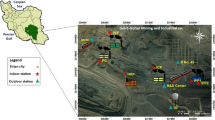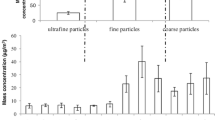Abstract
Oxidative stress and hydroxyl radicals (·OH) play important roles in adverse health effects caused by inhalable ambient air particles (PM10). The ultra-fine fraction of PM10 has been hypothesized as one of the critical contributors to ·OH generation. Both in vivo and in vitro studies have shown that ultra-fine particles (UFPs) or nano-particles generate more ·OH than larger particles with identical mass and composition. Both the surface area and surface-adsorbed redox-active metals have been suggested as factors to determine the oxidative capacity of UFPs. In this study, the ·OH-generating capability of different sizes of SiO2 particles was investigated in order to determine which factor influences particle-induced ·OH generation. The amount of ·OH generated in both acellular and cellular systems was quantified using a capillary electrophoresis method following exposure to SiO2 particles with diameters of 14, 100, and 500 nm. The amount of ·OH was strongly dependent on particle size, and a significant enhancement was observed only with 14 nm particles. Further studies indicated a close association between ·OH and iron ion concentration (R 2 = 0.812, p<0.01). Washed particles, with their surface iron being removed, did not generate ·OH. The iron-containing leachate from these washings was able to enhance ·OH production as untreated particles did. Therefore, the presence of adsorbed iron on the surface of the SiO2 particles is presented as a possible mechanism of UPFs-induced ·OH generation. The SiO2 acted as an inert substrate, and the surface of ultra-fine SiO2 particles acted as a carrier for iron.
Similar content being viewed by others
References
Hughes L S, Cass G R, Gone J, Ames M, Olmez I. Physical and chemical characterization of atmospheric ultrafine particles in the Los Angeles area. Environ Sci Technol, 1998, 32(9): 1153–1161
Chalupa D C, Morrow P E, Oberdörster G, Utell M J, Frampton M W. Ultrafine particle deposition in subjects with asthma. Environ Health Perspect, 2004, 112(8): 879–882
Peters A, Wichmann H E, Tuch T, Heinrich J, Heyder J. Respiratory effects are associated with the number of ultrafine particles. Am J Respir Crit Care Med, 1997, 155(4): 1376–1383
Wichmann H E, Spix C, Tuch T, Wölke G, Peters A, Heinrich J, Kreyling WG, Heyder J. Daily mortality and fine and ultrafine particles in Erfurt, Germany part I: Role of particle number and particle mass. Res Rep Health Eff Inst, 2000, (98): 5–86
Gilmour P S, Ziesenis A, Morrison E R, Vickers M A, Drost E M, Ford I, Karg E, Mossa C, Schroeppel A, Ferron G A, Heyder J, Greaves M, MacNee W, Donaldsona K. Pulmonary and systemic effects of short-term inhalation exposure to ultrafine carbon black particles. Toxicol Appl Pharmacol, 2004, 195(1): 35–44
Stoeger T, Reinhard C, Takenaka S, Schroeppel A, Karg E, Ritter B, Heyder J, Schulz H. Instillation of six different ultrafine carbon particles indicates a surface area threshold dose for acute lung inflammation in mice. Environ Health Perspect, 2006, 114(3): 328–333
Tao F, Gonzalez-Flecha B, Kobzik L. Reactive oxygen species in pulmonary inflammation by ambient particulates. Free Radical Bio Med, 2003, 35(4): 327–340
González-Flecha B. Oxidant mechanisms in response to ambient air particles. Mol Aspects Med, 2004, 25(1–2): 169–182
Oberdörster G. Toxicology of ultrafine particles: In vivo studies. Phil Trans R Soc A, 2000, 358(1775): 2719–2740
Beck-Speier I, Dayal N, Karg E, Maier K L, Schumann G, Schulz H, Semmler M, Takenaka S, Stettmaier K, Bors W, Ghio A, Samet J M, Heyder J. Oxidative stress and lipid mediators induced in alveolar macrophages by ultrafine particles. Free Radical Biol Med, 2005, 38(8): 1080–1092
Dick C A J, Brown D M, Donaldson K, Stone V. The role of free radicals in the toxic and inflammatory effects of four different ultrafine particle types. Inhal Toxicol, 2003, 15(1): 39–52
Lingard J J N, Tomlin A S, Clarke A G, Healey K, Hay A W M, Wild C P, Routledge M N. A study of trace metal concentration of urban airborne particulate matter and its role in free radical activity as measured by plasmid strand break assay. Atmos Environ, 2005, 39(175): 2377–2384
Brown D M, Stone V, Findlay P, MacNee W, Donaldson K. Increased inflammation and intracellular calcium caused by ultrafine carbon black is independent of transition metals or other soluble components. Occup Environ Med, 2000, 57(10): 685–691
Brown D M, Wilson M R, MacNee W, Stone V, Donaldson K. Size-dependent proinflammatory effects of ultrafine polystyrene particles: A role for surface area and oxidative stress in the enhanced activity of ultrafines. Toxicol Applied Pharmacol, 2001, 175(3): 191–199
Tokiwa H, Nobuyuki S, Nakanishi Y, Sagai M. 8-Hydroxyguanosine formed in human lung tissues and the association with diesel exhaust particles. Free Radical Biol Med, 1999, 27(11-12): 1251–1258
Afaq F, Abidi P, Matin R, Rahman Q. Cytotoxicity, Pro-oxidant effects and antioxidant depletion in rat lung alveolar macrophages exposed to ultrafine titanium dioxide. J Appl Toxicol, 1998, 18(5): 307–312
Donaldson K, Beswick P H, Gilmour P S. Free radical activity associated with the surface of particles: A unifying factor in determining biological activity? Toxicol Lett, 1996, 88(1–3): 293–298
Li Y, Zhu T, Guo X, Shang Y. Hydroxyl radicals induced by quartz particles in lung alveolar macrophages: The role of surface iron. Prog Nat Sci, 2006, 16(10): 1138–1144
Buettner G R, Jurkiewicz B A. Catalytic Metals, Ascorbate and free radicals: Combinations to avoid. Radiat Res, 1996, 145(5): 532–541
Hee S S, Won G B, Namhyun C. Effect of chelators and reductants on the mobilization of metals from ambient particulate matter. Environ Sci Technol, 2003, 37(16), 3531-3536
Coolen S A J, Huf F A, Reijenga J C. Determination of free radical reaction products and metabolites of salicylic acid using capillary electrophoresis and micellar electrokinetic chromatography. J Chromatogr B, 1998, 717(1-2): 119–124
Cao Y H, Chu Q C, Ye J N. Determination of hydroxyl radical by capillary electrophoresis and studies on hydroxyl radical scavenging activities of Chinese herbs. Anal Bioanal Chem, 2003, 376(5): 691–695
Galleano M, Aimo L, Puntarulo S. Ascorbyl radical/ascorbate ratio in plasma from iron overloaded rats as oxidative stress indicator. Toxicol Lett, 2002, 133: 192–201
Rahman Q, Norwood J, Hatch G. Evidence That exposure of particulate air pollutants to human and rat alveolar macrophages leads to differential oxidative response. Biochem Biophys Res Commun, 1997, 240(3): 669–672
Han J Y, Takeshita K, Utsumi H. Noninvasive detection of hydroxyl radical generation in lung by diesel exhaust particles. Free Radical Biol Med, 2001, 30(5): 516–525
Li N, Sioutas C, Cho A, Schmitz D, Misra C, Sempf J, Wang MY, Oberley T, Froines J, Nel A. Ultrafine particulate pollutants induce oxidative stress and mitochondrial damage. Environ Health Perspect, 2003, 111(4): 455–560
Shi T, Schins R P, Knaapen A M, Kuhlbusch T, Pitz M, Heinrich J, Borm P J. Hydroxyl radical generation by electron paramagnetic resonance as a new method to monitor ambient particulate matter composition. J Environ Monit, 2003, 5(4): 550–556
Kagan V E, Tyurina Y Y, Tyurin V A, Konduru N V, Potapovich A I, Osipov A N, Kisin E R, Schwegler-Berry D, Mercer R, Castranova V, Shvedova A A. Direct and indirect effects of single walled carbon nanotubes on RAW 264.7 macrophages: Role of iron. Toxicol Lett, 2006, 165(1): 88–100
Rizzio E, Giaveri G, Arginelli D, Gini L, Profumo A, Gallorin M. Trace elements total content and particle sizes distribution in the air particulate matter of a rural-residential area in north Italy investigated by instrumental neutron activation analysis. Sci Total Environ, 1999, 226(1): 47–56
Fernández-Espinosa A J, Ternero-Rodriguey M, Barragán de la Rosa F J, Jiménez Sánchez J C. Size distribution of metals in urban aerosols in Seville (Spain). Atmos Environ, 2001, 35(14): 2595–2601
Heal M R, Hibbs L R, Agius R M, Beverland L J. Total and water-soluble trace metal content of urban background PM10, PM2.5 and black smoke in Edinburgh, UK. Atmos Environ, 2005, 39(8): 1417–1430
De Freitas J M, Meneghini R. Iron and its sensitive balance in the cell. Mutat Res, 2001, 475(1–2): 153–159
Turi J L, Yang F, Garrick M D, Piantadosi C A, Ghio A J. The iron cycle and oxidative stress in the lung. Free Radical Biol Med, 2004, 36(7): 850–857
Ghio A J, Carter J D, Richards J H, Brighton L E, Lay J C, Devlin R B. Disruption of normal iron homeostasis after bronchial instillation of an iron-containing particle. Am J Physiol Lung Cell Mol Physiol, 1998, 18(3): L396–L403
Smith K R, Aust A E. Mobilization of iron from urban particulates leads to generation of reactive oxygen species in vitro and induction of ferritin synthesis in human lung epithelial cells. Chem Res Toxicol, 1997, 10(7): 828–834
Nemmar A, Hoet P H M, Vanquickenborne B, Dinsdale D, Thomeer M, Hoylaerts M F, Vanbilloen H, Mortelmans L, Nemery B. Passage of inhaled particles into the blood circulation in humans. Circulation, 2002, 105(4): 411–415
Elder A, Gelein R, Silva V, Feikert T, Opanashuk L, Carter J, Potter R, Maynard A, Ito Y, Finkelstein J, Oberdörster G. Translocation of inhaled ultrafine manganese oxide particles to the central nervous system. Environ Health Perspect, 2006, 114(8): 1172–1178
Oberdörster G, Ferin J, Lehner B E. Correlation between particle size, in vivo particle persistence, and lung injury. Environ Health Perspect, 1994, 102(Suppl 5): 173–179
Semmler-Behnke M, Takenaka S, Fertsch S, Wenk A, Seitz J, Mayer P, Oberdörster G, Kreyling W G. Efficient elimination of inhaled nanoparticles from the Alveolar region: Evidence for interstitial uptake and subsequent reentrainment onto airways epithelium. Environ Health Perspect, 2007, 115(5): 728–733
Adamson I Y, Letourneau H L, Bowden D H. Enhanced Macrophage-fibroblast interactions in the pulmonary interstitium increases fibrosis after silica injection to monocyte-depleted mice. Am J Pathol, 1989, 134(2): 411–418
Author information
Authors and Affiliations
Corresponding author
Additional information
Supported by the National Basic Research Priorities Program (Grant No. 2002CB410802) and the National Natural Science Foundation of China (Grant No. 20637020)
Rights and permissions
About this article
Cite this article
Shang, Y., Zhu, T., Li, Y. et al. Size-dependent hydroxyl radicals generation induced by SiO2 ultra-fine particles: The role of surface iron. Sci. China Ser. B-Chem. 52, 1033–1041 (2009). https://doi.org/10.1007/s11426-009-0141-9
Received:
Accepted:
Published:
Issue Date:
DOI: https://doi.org/10.1007/s11426-009-0141-9




